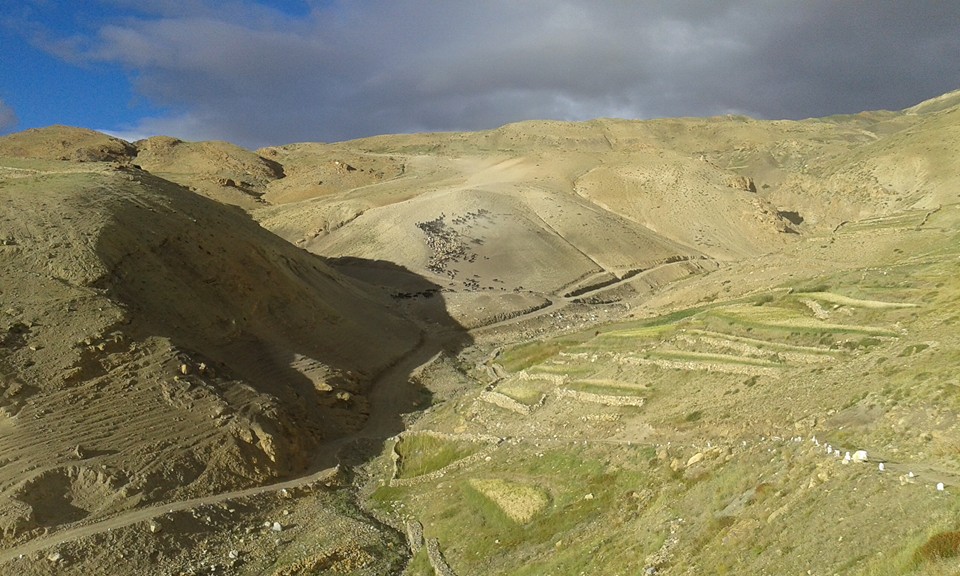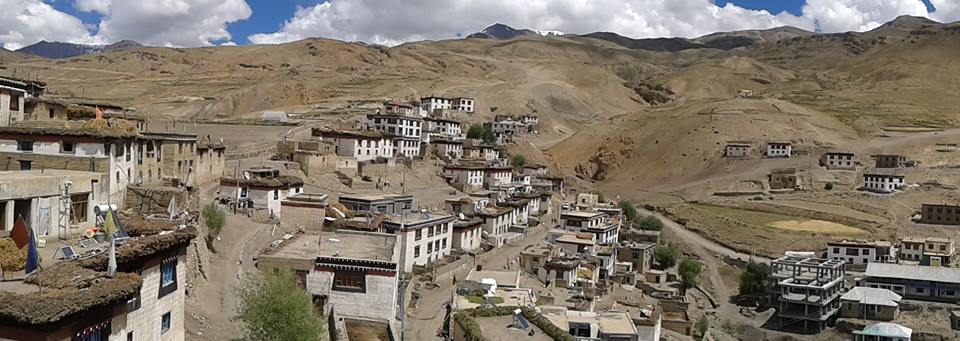
In the Spiti Valley everything is high. The lowest point is at 3000 meters, everything else is higher: villages, passes, mountains, monasteries…
Yes, there are also many monasteries here, not Christians want, but so-called Buddhist gompas for monks and nuns. The people in this remote high mountain desert near the Tibetan border are Buddhist and usually the second-born son is sent to one of the ancient Buddhist monasteries to receive an education as a monk.

The gompas are up to a thousand years old and mostly follow the Gelupka tradition. Every now and then the Dalai Lama comes to consecrate one of the monasteries (new or old) or to hold a ceremony.
It is particularly worthwhile to visit a gompa in the early hours of the morning, when the monks in their red robes hold their atmospheric ceremonies with chants and instruments!
The people of Spiti live mainly in small and very high villages – all are about 4000 meters high.

Hikkim has the highest post office in the world and the village of Kibber is said to be the highest permanently inhabited village with electricity and road access.
When it will be down to -30 °C in winter, the inhabitants of the other higher villages of Spitis will move further down into the valley towards the Spiti River, only the 80 families of the Kibber village will stay on top of 4270 meters!

The Spiti Valley belongs to the mountain state of Himachal Pradesh and can be reached from the south in two days from Shimla via the Hindustan-Tibet Highway and from the west over the Rothang and Kunzum Pass from Manali. But the mountain road is only during the summer month from June to September.
The small 120 km long valley is home to about 15,000 people and stretches from Tabo to Kunzum Pass.
Some interesting treks, such as the Pin-Parvati Pass Trek or the trek to Lake Tsomoriri over the Parangla Pass and there is also the one or the other beautiful peak that can be climbed here.

Otherwise, the valley is particularly attractive because of its interesting rough high mountain landscape with mountain lakes, glaciers and raging rivers, as well as the unique culture and way of life of the people!
Jeep safaris through the valley, but also homestay treks or bike tours are the ideal way to get to know the valley and its people.

Or you can do it, as we did and just live for a few days in one of the villages in a homestay.
It was not only wonderfully relaxing to live for a few days without internet, little electricity and without really having anything to do and at the same time to be a part of this nice village community.

On our walks through the village and across the fields, we became familiar with the physically busy everyday life of the people!
Each family has a few sheep, donkeys, yaks or hybrids of cow and yak. The farm animals help with work in the fields, as load animals, supply milk and are also meat suppliers during the long and cold winter months.

Every day it is a different villager, who goes up to the mountains with all the animals of the village at around 8 o’clock in the morning to spend the day in the pastures. In the evening around 6 o’clock the animals arrive safely in the village and are already expected by their owners to milk and feed them.
The villagers themselves work most of the time in their fields. Potatoes, barley and peas are grown here.
The peas, which become particularly sweet and large here in the intense high sun, are sold at good prices, while the barley is mainly used for personal use, both for the production of alcohol, as well as a nutritious Tsampa (roasted barley), which is eaten almost at all times of the day.

In addition, people here eat soups, dairy products, such as yoghurt and cheese, and of course meat.
Mainly the women do the hard field work, while the men having a job down in the district capital in Kaza. The only bus leaves Kibber at 8 o’clock in the morning and returns to Kaza at 5 o’clock in the evening. Women can be seen working hard in the high sun in the dusty fields, looking almost 20 years older than their husbands!
But they are always friendly. On our walks through the fields, we were repeatedly involved in a little chat and we were given peas to snack on!
People are not only Buddhist, but also live their faith! Our host at the Homestay sang the holy prayers every morning for an hour, while the his wife smoked the house with a coal fire.

The older village women, who are too old to work, sit for hours in the small prayer rooms of ancient gompas to turn to holy mantras, huge prayer mills to send peace to the world.
Kibber itself has several gompas that invite for a visit!
There is also a small school where students can go up to 10 grades. A teacher’s house was built specifically for this purpose, in which now 5 trained teachers from outside live.
People here speak a language similar to Tibetan, but you can also communicate a bit in Hindi and a little less in English.
In the meantime, tourism has also come as far as Kibber. Some families run small inns, others are trekking guides or horsemen and can earn some extra money in the months from July to September. Because the summer season is short, the passes only open late in the year around mid-July and close in September with the first snowfall.

With the onset of winter, it gets a little quieter and you have chances to see a snow leopard. The blue sheep, ibex, marmots and eagles you can see also in the summer month.

In the cooler evenings, we often spent time in the dining room, sitting on pillows at low tables, eating tasty soups, playing, painting or just looking out the window!
We lived really comfortably in our homestay, with private bathroom and hot water from solar cells.

Most other houses in the village also have solar cells, because they are supported here by the state. But bathrooms are otherwise searched in vain. A hole next to the cowshed serves as a toilet.

By the way, if you get bored, then you just go for a hike, visit the surrounding monasteries, help the women or collect fossils! Yes, you read correctly! The fossils lie everywhere around here, like sand by the sea. 500 Milion years ago tehre used to be the Tethys Sea, before the formation of the Himalayas. And so it happens that the area around Kibber is an archaeological museum!






